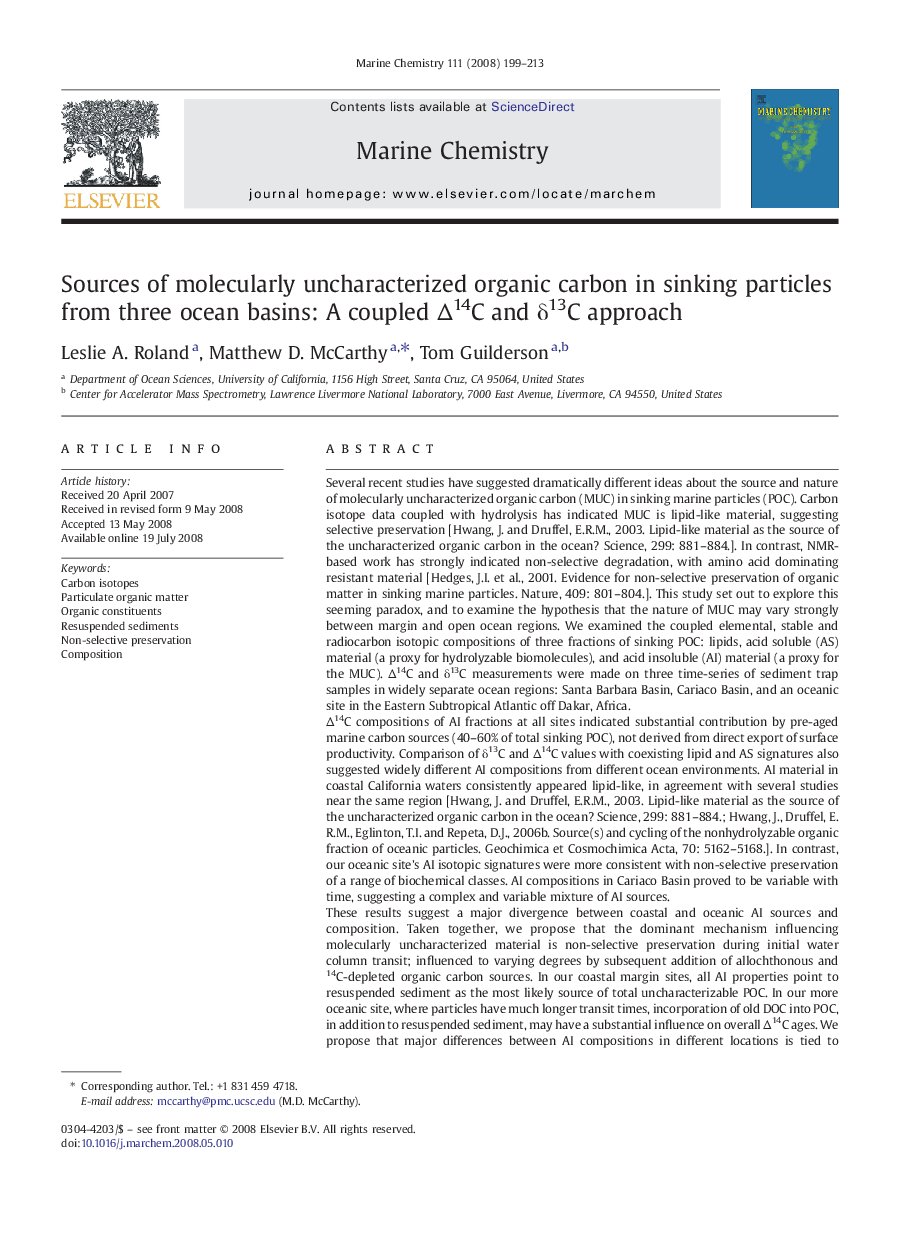| کد مقاله | کد نشریه | سال انتشار | مقاله انگلیسی | نسخه تمام متن |
|---|---|---|---|---|
| 1263468 | 1496718 | 2008 | 15 صفحه PDF | دانلود رایگان |

Several recent studies have suggested dramatically different ideas about the source and nature of molecularly uncharacterized organic carbon (MUC) in sinking marine particles (POC). Carbon isotope data coupled with hydrolysis has indicated MUC is lipid-like material, suggesting selective preservation [Hwang, J. and Druffel, E.R.M., 2003. Lipid-like material as the source of the uncharacterized organic carbon in the ocean? Science, 299: 881–884.]. In contrast, NMR-based work has strongly indicated non-selective degradation, with amino acid dominating resistant material [Hedges, J.I. et al., 2001. Evidence for non-selective preservation of organic matter in sinking marine particles. Nature, 409: 801–804.]. This study set out to explore this seeming paradox, and to examine the hypothesis that the nature of MUC may vary strongly between margin and open ocean regions. We examined the coupled elemental, stable and radiocarbon isotopic compositions of three fractions of sinking POC: lipids, acid soluble (AS) material (a proxy for hydrolyzable biomolecules), and acid insoluble (AI) material (a proxy for the MUC). Δ14C and δ13C measurements were made on three time-series of sediment trap samples in widely separate ocean regions: Santa Barbara Basin, Cariaco Basin, and an oceanic site in the Eastern Subtropical Atlantic off Dakar, Africa.Δ14C compositions of AI fractions at all sites indicated substantial contribution by pre-aged marine carbon sources (40–60% of total sinking POC), not derived from direct export of surface productivity. Comparison of δ13C and Δ14C values with coexisting lipid and AS signatures also suggested widely different AI compositions from different ocean environments. AI material in coastal California waters consistently appeared lipid-like, in agreement with several studies near the same region [Hwang, J. and Druffel, E.R.M., 2003. Lipid-like material as the source of the uncharacterized organic carbon in the ocean? Science, 299: 881–884.; Hwang, J., Druffel, E.R.M., Eglinton, T.I. and Repeta, D.J., 2006b. Source(s) and cycling of the nonhydrolyzable organic fraction of oceanic particles. Geochimica et Cosmochimica Acta, 70: 5162–5168.]. In contrast, our oceanic site's AI isotopic signatures were more consistent with non-selective preservation of a range of biochemical classes. AI compositions in Cariaco Basin proved to be variable with time, suggesting a complex and variable mixture of AI sources.These results suggest a major divergence between coastal and oceanic AI sources and composition. Taken together, we propose that the dominant mechanism influencing molecularly uncharacterized material is non-selective preservation during initial water column transit; influenced to varying degrees by subsequent addition of allochthonous and 14C-depleted organic carbon sources. In our coastal margin sites, all AI properties point to resuspended sediment as the most likely source of total uncharacterizable POC. In our more oceanic site, where particles have much longer transit times, incorporation of old DOC into POC, in addition to resuspended sediment, may have a substantial influence on overall Δ14C ages. We propose that major differences between AI compositions in different locations is tied to variation in availability of such pre-aged OC sources, linked to regional oceanographic conditions and strongly influenced by proximity to continental shelves. The strong correlations we observe between %AI vs. %AS composition and elemental and isotopic values also implies that substantial amounts of POC collected via sediment traps in some locations is not exported directly from surface production, but added from other pre-aged reservoirs.
Journal: Marine Chemistry - Volume 111, Issues 3–4, 16 September 2008, Pages 199–213